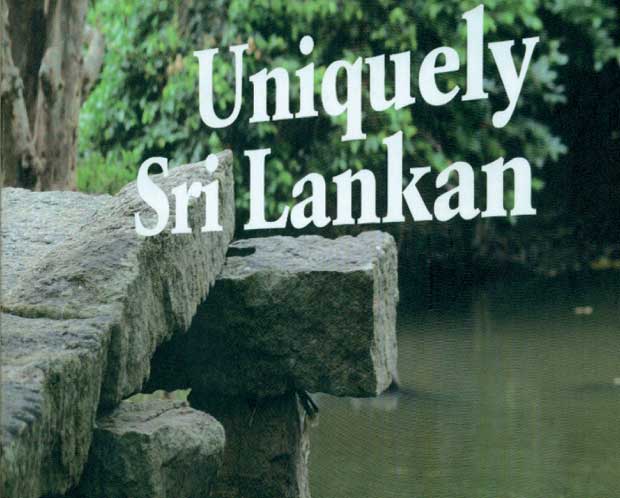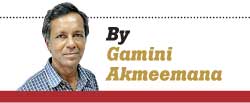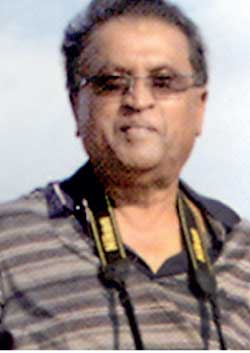Reply To:
Name - Reply Comment
Last Updated : 2024-04-19 06:03:00

At first glance, “Uniquely Sri Lankan” might look like just another of that abundant crop of travel books on Sri Lanka.
 But authors Siri Ipalwatte and Kim Wells have chosen their themes well, and have done their homework, and the result is a rewarding piece of reading accompanied by excellent photographs.
But authors Siri Ipalwatte and Kim Wells have chosen their themes well, and have done their homework, and the result is a rewarding piece of reading accompanied by excellent photographs.
Siri Ipalwatte left Sri Lanka in the early 70s looking for better prospects in the UK. Kim Wells has often accompanied him to Sri Lanka over the years, and they share a passionate interest in the history of Robert Knox, the English sailor who was held captive in Kandy by King Rajasinghe II in the 17th century.
In fact, the story which traces Knox’s route during his escape to Dutch-held East is the first in a series of fourteen chapters, which explore various facets of Sri Lanka’s history and culture, ranging from the aadivasi community (the Veddahs) to the rituals of exorcism.
What sets it apart from the usual travel book is the reminiscing – both writers recall earlier experiences while living and travelling in the island, which lends the writing a kind of depth lacking in a purely contemporary account.
 The second chapter titled “Peddling to freedom” too, is an original piece of writing whereby Kim Wells traces the footsteps of the two English escapees – Robert Knox and Stephen Rutland – in their all-out bid for freedom, and the writer has literally done the leg work. This isn’t just a series of vistas seen through a car window.
The second chapter titled “Peddling to freedom” too, is an original piece of writing whereby Kim Wells traces the footsteps of the two English escapees – Robert Knox and Stephen Rutland – in their all-out bid for freedom, and the writer has literally done the leg work. This isn’t just a series of vistas seen through a car window.
It’s a good detective story, too, as Knox didn’t leave behind a detailed map of his escape route. It is doubtful if Knox had seen any map of the island; in any case, 17th century maps of the island still left much to the imagination. It is good luck and ‘dead reckoning’ which got Knox and his partner to safety. The authors’ passion for this particular historical incident can be felt through the illustrated account. As they say in their own words: “Our own ‘pursuit’ of Robert Knox and Stephen Rutland had taken even our much-travelled driver into new territory and heightened our admiration for the resilience and resourcefulness of the two. Could we have done it? Maybe, but by now we have the excuse of the ages – age itself and a predilection for comfort!”
Exorcism is a hackneyed theme in travel writing. But it is explored in this book without condescension, and with awareness that the ritual isn’t unique to Sri Lanka (a modern case from Australia is given).
What sets it apart from the usual travel book is the reminiscing – both writers recall earlier experiences while living and travelling in the island, which lends the writing a kind of depth lacking in a purely contemporary account.
The writers discuss the struggle of present-day practitioners to keep alive this ancient ritual, and offer a detailed account of an actual ceremony in the case of a possessed young woman. As they put it:
“Thovil is part of a holistic understanding that the physical condition of the body is inseparable from the mental condition. Modern ‘common sense’ might suggest that the practice we saw should by now have been relegated to oblivion; yet it is still alive and well and being defended, even in its extreme forms, as in the manslaughter case from Australia. The presence of a demonic spirit in the body is believed to override the physical body of the possessed and to control their every move. A sense that the yakka was truly present implicates all parties, not only yakkadura and the patient, but also spectators, as complicit in expelling the yakka from its human host.
“Before assuming that science is antipathetic to certain types of belief system, it is worth bearing in mind that medical science can now be used in modern ways to support such beliefs and rituals if that helps people and communities.”
This empathy with local tradition and psyche runs through the book. In describing a visit to the ancient Buddhist shrine of Divaguhawa, the authors try to view the pilgrimage through the eyes and mind of a pilgrim – in this case, an old woman clearly exhausted by the rigorous climb.
All in all, this a very intelligently written book, articulate, sympathetic though not sentimental, a visual and cerebral pleasure as far as both print and images are concerned.
“Why risk your health by walking up to the top?” I asked her.
“Saman Deviyo will look after me,” smiled hopefully and took a drink from her water bottle. Then she said: “You have to give before you can expect to receive.”
The writers have the knack of describing the highlights of a place, or that crucial moment of a visit which lifts it above the ordinary, with simplicity and clarity. This is how sighting a leopard at Yala is described: “Right there, 20 meters from us, a leopard was sitting yawning unperturbed by our presence. For about five minutes, one of the greatest leopard shows on earth took place right before my eyes. I fumbled with my camera to capture the moment, but also made sure to watch without looking through the lens.
 “I wanted to remember this. It was the very best of Discovery Channel coming to me live and in 3D. For a minute or two it stared straight at us – eyes locked on ours with the intense scrutiny of a supreme predator. And then, in a flash, he was gone. We stood there, stunned. I sat back, feeling a little drained – sad, too. It was the briefest of encounters – an exchange of glances that jolted the senses, seared the mind.”
“I wanted to remember this. It was the very best of Discovery Channel coming to me live and in 3D. For a minute or two it stared straight at us – eyes locked on ours with the intense scrutiny of a supreme predator. And then, in a flash, he was gone. We stood there, stunned. I sat back, feeling a little drained – sad, too. It was the briefest of encounters – an exchange of glances that jolted the senses, seared the mind.”
Siri Ipalwatte strikes a personal note, heavy with nostalgia, in ‘Coming home.’ The southern fishing port and coastal town of Weligama is the location, last visited by him in 1978 when his father died. It’s a rambling narrative about change, childhood memories, and the culture, crafts and atmosphere of the place. Other chapters cover the cinnamon trade, wild elephants of Minneriya, the Jaffna peninsula, a drive along the East Coast, Sinharaja forest, the ancient monastery of Ritigala and vistas from Galle to Dondra.
All in all, this a very intelligently written book, articulate, sympathetic though not sentimental, a visual and cerebral pleasure as far as both print and images are concerned.

Add comment
Comments will be edited (grammar, spelling and slang) and authorized at the discretion of Daily Mirror online. The website also has the right not to publish selected comments.
Reply To:
Name - Reply Comment
On March 26, a couple arriving from Thailand was arrested with 88 live animal
According to villagers from Naula-Moragolla out of 105 families 80 can afford
Is the situation in Sri Lanka so grim that locals harbour hope that they coul
A recent post on social media revealed that three purple-faced langurs near t